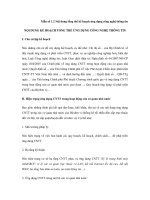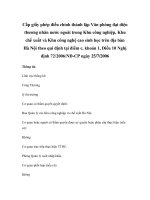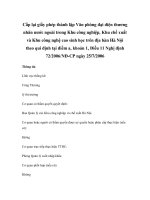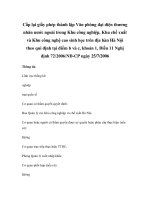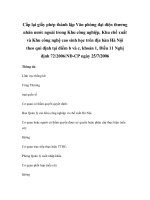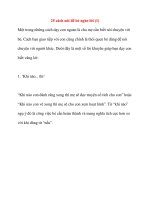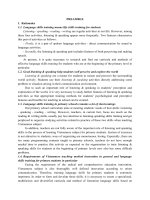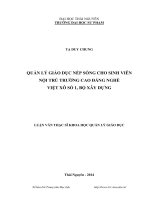Nghe nói 1 (ENGL1304) Nghe Noi 1 ENGL1304
Bạn đang xem bản rút gọn của tài liệu. Xem và tải ngay bản đầy đủ của tài liệu tại đây (162.05 KB, 7 trang )
BỘ GIÁO DỤC VÀ ðÀO TẠO
TRƯỜNG ðẠI HỌC MỞ TP.HCM
CỘNG HÒA XÃ HỘI CHỦ NGHĨA VIỆT NAM
ðộc lập – Tự do – Hạnh phúc
CHƯƠNG TRÌNH ðẠI HỌC / CAO ðẲNG
NGÀNH ðÀO TẠO: CỬ NHÂN TIẾNG ANH
ðỀ CƯƠNG CHI TIẾT MÔN HỌC
1. THÔNG TIN CHUNG VỀ MÔN HỌC
1.1 Tên môn học:
Nghe Nói 1
1.2 Mã môn học:
ENGL1304
1.3 Trình ñộ:
ðại học / Cao ñẳng
1.4 Ngành:
Cử nhân Tiếng Anh
1.5 Khoa phụ trách:
Khoa Ngoại ngữ
1.6 Số tín chỉ:
3 (45 tiết)
1.7 Yêu cầu ñối với môn học:
- ðiều kiện tiên quyết: Không có
- Yêu cầu khác:
Không có
1.8 Yêu cầu ñối với sinh viên:
-
Tham dự lớp ít nhất 80% số tiết quy ñịnh.
-
Tự học các phần nội dung ñược chương trình và giáo viên quy ñịnh.
-
Tự trang bị giáo trình học tập chính.
-
Tham gia các hoạt ñộng lớp do giáo viên tổ chức.
2. MÔ TẢ MÔN HỌC VÀ MỤC TIÊU
2.1 Môn Nghe Nói 1 là môn thực hành kỹ năng nghe nói ñầu tiên trong 6 cấp ñộ Nghe Nói của
chương trình ñào tạo cử nhân Tiếng Anh bậc ñại học / 4 cấp ñộ của chương trình ñào tạo cử
nhân Tiếng Anh cao ñẳng. ðây cũng là môn ñiều kiện ñể sinh viên có thể học tiếp môn Nghe
Nói 2.
Ngoài việc thực hành giao tiếp ngôn ngữ nói bằng Tiếng Anh ở trình ñộ sơ trung cấp (preintermediate), môn học còn giúp sinh viên từng bước phát triển các kỹ năng mềm, ñặc biệt là
khả năng tự học và khả năng làm việc nhóm.
2.2 Sau khi hoàn tất chương trình, sinh viên có thể nghe hiểu nội dung chính các bài hội thoại và
bài nói ngắn ở mức ñộ sơ trung cấp, và có thể giao tiếp về những chủ ñề thông dụng hàng ngày.
3. HỌC LIỆU
3.1 Giáo trình chính:
o Tanka, Judith & Most, Paul. 2007. Interactions One: Listening/ Speaking, Silver
Edition, McGraw-Hill.
o Rogers, Bruce. 2002. Peterson’s TOEFL CBT Success, Thompson.
1
3.2Một số tài liệu tham khảo:
o Anderson, Jason. 2006. Role Plays for Today. Delta Publishing.
o Gammidge, Mick. 2004. Speaking Extra: A resource book of multi-level skills
activitie. Cambridge University Press.
o Jones, Leo. 2002. Let’s Talk 1. Cambridge University Press
o Helgesen, Marc & Brown, Steve. 1994. Active Listening One: Building Skills for
Understanding. Cambridge University Press.
o Miller, George S. 2000. Cracking the TOEFL. Princeton Review Publishing.
o Pyle, Micheal A. & Page, Mary Ellen Munos. 2001 – 2002. Cliff TOEFL,
Preparation Guide. 5th ed. ETS.
o Pamela, Shape J. 2001. How to Prepare for the TOEFL®, 10th ed. Baron’s
Educational, Inc.
o Ramsey, Gaynor & Rees-Parnall, Hilary. 1989. Well Spoken. Longman.
o Richards, Jack C. 1997. New Interchange One & Two, Cambridge University Press.
o Richards, Jack C. 1995. Listen for it. Oxford University Press.
o Gallagher, Nancy. 2004. DELTA’s Key to the TOEFL® Test. Delta Publishing Co.
o Wilson, Warren & Barnard, Roger. 1998. Fifty-Fifty One: A Course in
Communicative English. Longman.
4. ðÁNH GIÁ KẾT QUẢ HỌC TẬP
Kết quả học tập của sinh viên ñược ñánh giá qua các tiêu chí như sau:
1. Tham gia các hoạt ñộng lớp (class participation):
-
Sinh viên tham gia hoạt ñộng lớp ñược cộng ñiểm thưởng vào phần thi nói cuối khóa.
-
Phần ñiểm thưởng không quá 40% phần ñiểm thi nói.
2. Thi Nghe cuối khóa (end-of-course listening test):
Dạng câu hỏi
Số lần nghe
Số câu hỏi
Thang ñiểm
(10 ñiểm)
Trả lời ngắn
(short answers for main ideas or details)
02
10
02
ðiền từ vào bài tóm tắt/ dàn ý cho sẵn
(summary/outline filling)
02
15
03
Trắc nghiệm
(TOEFL multiple choice questions for short
conversations)
01
25
05
Ghi chú:
Nội dung các bài nghe bao gồm các phần ñược học trong lớp, phần tự học (xem mục
5.2. – phân bố chương trình) và phần nội dung mới (do giáo viên quy ñịnh).
2
3. Thi Nói cuối khóa (end-of-course speaking test):
Hình thức
Nội dung
Thang ñiểm
(10 ñiểm)
Phỏng vấn (GV
(interview)
SV)
Trả lời câu hỏi về thông tin cá nhân
(factual information of personal kind)
05
ðàm thoại (SV
(conversations)
SV)
Hỏi ñáp dựa trên gợi ý cho sẵn
(question and answer using prompt materials)
05
Ghi chú:
Nội dung các câu hỏi thi nói phù hợp với mục tiêu thực hành trong chương trình học.
Sinh viên không ñược giáo viên cho câu hỏi trước.
4. ðiểm môn học:
ðiểm môn học = (ñiểm thi nghe + ñiểm thi nói) / 2
5. NỘI DUNG CHI TIẾT MÔN HỌC
5.1 Tóm tắt nội dung:
Trong chương trình Nghe Nói 1, sinh viên sẽ ñược:
1. Luyện tập nghe hiểu và thực hành các kỹ năng ñàm thoại cơ bản (basic listening and
conversational strategies) sau:
-
nghe và phân biệt các từ có dấu nhấn (stressed words), và dạng rút gọn thông dụng trong
ngôn ngữ nói (reductions),
-
nghe hiểu các ý chính của hội thoại,
-
thực hành các giao tiếp trong các tình huống xã hội (social interactions), nhấn mạnh kỹ
năng trao ñổi thông tin (information exchange), miêu tả sự vật và diễn ñạt các thông tin cá
nhân (factual description of personal and non-personal kinds), và diễn ñạt ý kiến
(expressing opinions)
2. Làm quen và thực hành phần 1 bài thi nghe TOEFL – nghe các mẫu hội thoại ngắn (listening
for short conversations), tập trung vào những kỹ năng ñể làm bài thi TOEFL giấy.
3
6
3
6
(period)
Time
Learning objectives
To listen to a conversation and distinguish between main ideas and
details. (1)
To identify and practice stressed words. (2)
To compare and practice reduced and unreduced of auxilaries and
some prepositions. (3)
To distinguish and pronounce can and can’t. (4)
To talk about abilities. (5)
To listen to a story and practice summarizing ideas using key words.(6)
To practice using context clues to identify seasons. (7)
To talk about the weather and seasons. (8)
To express likes and dislikes. (9)
To discuss vacation plan.
To focus on the TOEFL test:
3. Listening for key words (1)
4. Identifying sound confusion (2)
5. Identifying homonyms and words with multiple meanings (3)
To practice predicting the content before listening. (1)
To listen to a conversation and distinguish between main ideas and
details. (2)
To identify and practice stressed words. (3)
To compare and practice reduced and unreduced of simple present
tense auxilaries and some prepositions. (4)
To distinguish and pronounce among -s endings (5)
To introduce oneself using casual expressions for making friends. (6)
To listen to a presentation and practice summarizing ideas using key
words. (7)
To practice using context clues to guess the correct answers to
questions. (8)
To discuss body language. (9)
5.2 Nội dung chi tiết môn học:
(1 - 9) Tanka & Most (2004), p. p. 25-38
(2) Richards (1995), p. p.12, 38
(2) Richards (1995), p. 76
(7 – 8) Jones (2002), p.p. 14-7
(1) Gallagher (2004), p.p. 36-40
(1) Miller (2000), p.p. 22-6
(2) Rogers (2002), p.p. 22-4
(3) Rogers (2002), p.p. 25-8
(3) Miller (2000), p.p. 30-4
(1 – 9) Tanka & Most (2007), p. 4-17
(1) Wilson & Barnard (1998), p.p.68-72
(1) Jones (2002), p.p. 2-3, 10-2.
(6) Richards (1997), p.p.2-5
(6) Wilson & Barnard, p.p.2-4
(9) Richards (1997), p.p. 5-7
(9) Ramsey (1994), p.p. 15-7
Suggested resources
(2), (4), (5), (6), (7), & (8) are
for self-study.
Basic strategies are introduced
and practiced in class;
Students are expected to do
more home listening of the
same types.
Notes
4
Time
6
To talk about running errands. (1)
To identify and practice stressed words.(2)
To compare and practice reduced and unreduced forms. (3)
To describe a location in the city. (4)
To describe the neighbohood. (5)
To listen and follow directions. (6)
To listen to a conversation and take notes using a concept map to make
comparisons (7)
To practice using context clues to guess locations. (8)
To focus on the TOEFL test:
Listening for Conditionals, Causatives, and Modals (1)
Listening for negative expressions (2)
Listening for time, quantity, and comparisons (3)
Understanding intonation (4)
3
7.
8.
9.
10.
To listen to a conversation and distinguish between main ideas and
details. (1)
To identify and practice stressed words. (2)
To compare and practice reduced and unreduced forms. (3)
To distinguish and practice saying teen and ten. (4)
To listen to radio advice on healthy eating and take note on causes and
effect. (5)
To interview and compare eating habits.(6)
To practice using context clues to guess locations. (7)
To practice ordering food in a restaurant. (8)
To listen and take notes on a process. (9)
To discribe a process of making recipe. (10)
To focus on the TOEFL test:
6. Listening for idioms (1)
Learning objectives
6
3
(period)
Basic strategies are introduced
and practiced in class;
Students are expected to do
more home listening of the
same types.
(2), (6) & (8) are for selfstudy.
(1 – 8) Tanka & Most (2007), p.p. 64-79
(4 – 5) Jones (2002), p.p. 46-8
(4 – 5) Richards (1997), (1) p.p. 46-51
(6) Richards (1995), p.p. 55-6
(1), (2), (4), (6), (7), (8) & (10)
are for self-study.
(1 – 10) Tanka & Most (2007), p. 43-58
(4) Richards (1995), p.p.19-22, 49-52
(6) Jones (2002). p.26
(8) Richards (1997), (1) p.p.80 – 84
(9) Ramsey (1994), p.p.13-4
(9 - 10) Richards (1997), (2) p.p. 20-25
(1 - 4) Gallangher (2004), p.p. 51-66
Basic strategies are introduced
and practiced in class;
Students are expected to do
more home listening of the
same types .
Notes
(1) Gallagher (2004), p.p. 41-7
(1) Rogers (2002), p.p. 29-33
(1) Miller (2002), p.p.34-47
Suggested resources
5
Time
To focus on the TOEFL test:
11. Listening for dialogues involving agreements & disagreements (1)
12. Listening for dialogues involving suggestions, invitations, offers, and
requests (2)
13. Listening for dialogues involving contradictions, assumptions (3)
14. Answering inference questions about dialogues (4)
To listen to a conversation and distinguish between main ideas and
details.(1)
To identify and practice stressed words.(2)
To compare and practice reduced and unreduced forms.
To distinguish and practice among –ED endings. (3)
To describe a moving day.
To ask for information about apartments. (4)
To describe a house / an apartment.
To listen to a house tour and take notes while separating positive and
negative details (5)
To practice making and answering requests. (6)
To practice using context clues to guess what speakers are implying.
(7)
To listen and follow house-sitting instructions. (8)
Assessment
6
3
Learning objectives
3
(period)
(2), (3), (7), & (8) are for selfstudy.
(1 – 9) Tanka & Most (2007), p.p. 85-98
(4) Jones (2002), p.p. 60-1
(4) Richards (1997), (1) p.p.49-50
(4 – 5) Richards (1997), (2) p.p.14-16
End-of-course speaking test
Basic strategies are introduced
and practiced in class;
Students are expected to do
more home listening of the
same types.
Notes
(1 - 4) Rogers (2002), p.p. 34-48
Suggested resources
6
7. GIẢNG VIÊN BIÊN SOẠN
•
Họ và tên: Nguyễn Thị Hoài Minh
•
Chức danh, học hàm, học vị: Giảng viên – Thạc sỹ
•
Thời gian, ñịa ñiểm làm việc: ðH Mở Tp. Hồ Chí Minh, 97 Võ Văn Tần, Q3
•
ðịa chỉ liên hệ: ðH Mở Tp. Hồ Chí Minh
•
ðiện thoại, email: 0904421292 -
Ban giám hiệu
Trưởng phòng QLðT
Trưởng khoa
7
